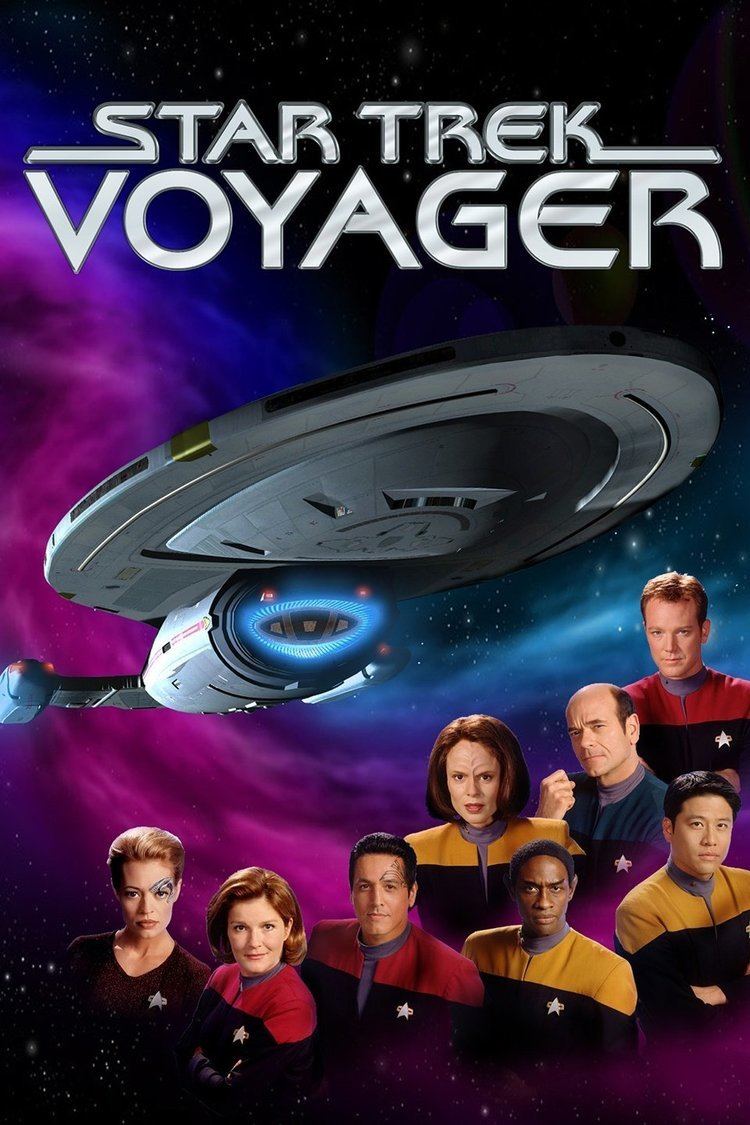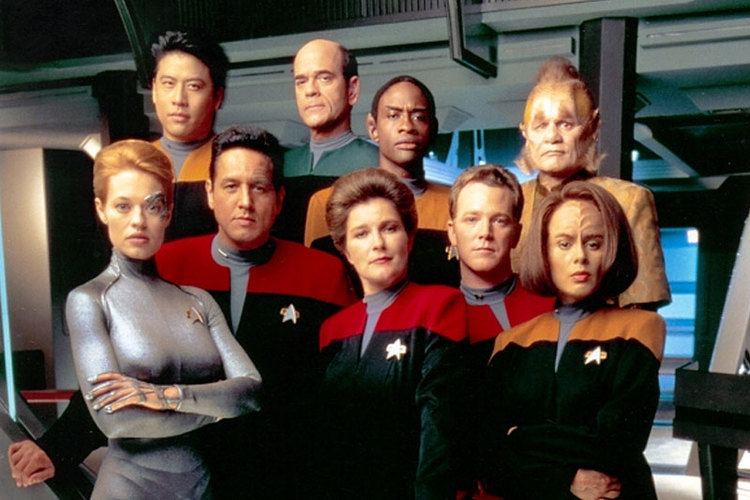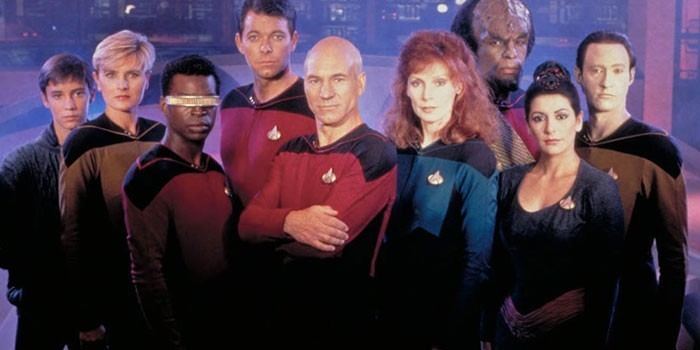9.4 /10 3 Votes
8.8/10 TV Country of origin United States Final episode date 23 May 2001 | 7.7/10 IMDb First episode date 16 January 1995 | |||||||||||||||||||||||||||||||||
 | ||||||||||||||||||||||||||||||||||
Genre Science fictionAction adventure Created by Rick BermanMichael PillerJeri Taylor Starring Kate MulgrewRobert BeltranRoxann DawsonJennifer LienRobert Duncan McNeillEthan PhillipsRobert PicardoTim RussJeri RyanGarrett Wang Cast Profiles | ||||||||||||||||||||||||||||||||||
Star trek borg
Star Trek: Voyager is a science fiction television series, set in the Star Trek universe.
Contents
- Star trek borg
- Star trek voyager 1995 tv series
- Production
- Plot overview
- Nonactors
- Actors
- Characters and races
- Actors from other Star Trek incarnations appearing on Voyager
- Actors from Voyager appearing on other Star Trek incarnations
- Behind the scenes connections
- Music
- Novels and revival attempts
- Book relaunch
- Cultural influence
- References
The series takes place during the years 2371 to 2378. It follows the adventures of the Starfleet vessel USS Voyager, which becomes stranded in the Delta Quadrant (on the far side of the Milky Way galaxy, 70,000 light-years from Earth) while searching for a renegade Maquis ship. Voyager has to make the estimated 75-year journey home.

The series was created by Rick Berman, Michael Piller, and Jeri Taylor, and is the fifth incarnation of Star Trek, which began with the 1960s series Star Trek: The Original Series that was created by Gene Roddenberry. Voyager was produced for seven seasons, from 1995 to 2001, and is the first and only Star Trek TV series with a female captain, Kathryn Janeway (played by Kate Mulgrew), as the lead character. Berman served as head executive producer in charge of the overall production for the series during its entire run. He was assisted by a second in command executive producer who generally functioned as the day-to-day showrunner. Four were used throughout the series' run: Michael Piller (EP/showrunner – first and second season), Jeri Taylor (EP – first through fourth seasons, showrunner – third and fourth seasons), Brannon Braga (EP/showrunner – fifth and sixth seasons), and Kenneth Biller (EP/showrunner – seventh season).

Star Trek: Voyager aired on UPN and was the network's second-longest running series.
Star trek voyager 1995 tv series
Production

As Star Trek: The Next Generation ended, Paramount Pictures wanted to continue to have a second Star Trek TV series to accompany Star Trek: Deep Space Nine. The studio also planned to start a new television network, and wanted the new series to help it succeed. This was reminiscent of Paramount's earlier plans to launch its own network by showcasing Star Trek: Phase II in 1977.

Initial work on Star Trek: Voyager began in 1993, when the seventh and final season of Star Trek: The Next Generation and the second season of Star Trek: Deep Space Nine were in production. The development of the seventh Star Trek film, Star Trek Generations, and seeds for the show's backstory, including the development of the Maquis, were placed in several The Next Generation and Deep Space Nine episodes. Voyager was shot on the stages The Next Generation had used, and where the Voyager pilot "Caretaker" was shot in September 1994. Costume designer Robert Blackman decided that the uniforms of Voyager's crew would be the same as those on Deep Space Nine.
Star Trek: Voyager was the first Star Trek series to use computer-generated imagery (CGI), rather than models, for exterior space shots. seaQuest DSV and Babylon 5 had previously used CGI to avoid the expense of models, but the Star Trek television department continued using models because they felt they were more realistic. Amblin Imaging won an Emmy for Voyager's opening CGI title visuals, but the weekly episode exteriors were captured with hand-built miniatures of Voyager, its shuttlecraft, and other ships. This changed when Voyager went fully CGI for certain types of shots midway through season three (late 1996). Foundation Imaging was the studio responsible for special effects during Babylon 5's first three seasons. Season three's "The Swarm" was the first episode to use Foundation's effects exclusively. Star Trek: Deep Space Nine began using Foundation Imaging in conjunction with Digital Muse one year later (season six). In its later seasons, Voyager featured visual effects from Foundation Imaging and Digital Muse. The digital effects were produced at television resolution and therefore the series cannot be re-released in HD format without re-creating the special effects.
Plot overview
In the pilot episode, "Caretaker", USS Voyager departs the Deep Space Nine space station on a mission into the treacherous Badlands. They are searching for a missing ship piloted by a team of Maquis rebels, which Voyager's security officer, the Vulcan Lt. Tuvok, has secretly infiltrated. While in the Badlands, Voyager is enveloped by a powerful energy wave that kills several of its crew, damages the ship, and strands it in the galaxy's Delta Quadrant, more than 70,000 light-years from Earth.
There, Voyager finds the Maquis ship, and eventually the two crews reluctantly agree to join forces to survive their journey home. Chakotay, leader of the Maquis group, becomes Voyager's first officer. B'Elanna Torres, a half-human/half-Klingon Maquis, becomes chief engineer. Tom Paris, whom Janeway released from a Federation prison to help find the Maquis ship, is made Voyager's helm officer. Due to the deaths of the ship's entire medical staff, the Doctor, an emergency medical hologram designed only for short-term use, is employed as the ship's full-time chief medical officer. Delta Quadrant natives Neelix, a Talaxian scavenger, and Kes, a young Ocampa, are welcomed aboard as the ship's chef/morale officer and the doctor's medical assistant, respectively.
Due to its great distance from Federation space, the Delta Quadrant is unexplored by Starfleet, and Voyager is truly going where no man has gone before. As they set out on their projected 75-year journey home, the crew passes through regions belonging to various species: the barbaric and belligerent Kazon; the organ-harvesting, disease-ravaged Vidiians; the nomadic hunter race the Hirogen; the fearsome Species 8472 from fluidic space; and most notably the Borg, whose home is the Delta Quadrant, so that Voyager has to move through large areas of Borg-controlled space in later seasons. They also encounter perilous natural phenomena, a nebulous area called the Nekrit Expanse ("Fair Trade", third season), a large area of empty space called the Void ("Night", fifth season), wormholes, dangerous nebulae, and other anomalies.
However, Voyager does not always deal with the unknown. It is the third Star Trek series to feature Q, an omnipotent alien—and the second on a recurring basis, as Q made only one appearance on Star Trek: Deep Space Nine. Starfleet Command learns of Voyager's survival when the crew discovers an ancient interstellar communications network, claimed by the Hirogen, into which they can tap. This relay network is later disabled, but due to the efforts of Earth-based Lieutenant Reginald Barclay, Starfleet eventually establishes regular contact in the season-six episode "Pathfinder", using a communications array and micro-wormhole technology.
In the first two episodes of the show's fourth season, Kes leaves the ship in the wake of an extreme transformation of her mental abilities, while Seven of Nine (known colloquially as Seven), a Borg drone who was assimilated as a six-year-old human girl, is liberated from the collective and joins the Voyager crew. As the series progresses, Seven begins to regain her humanity with the ongoing help of Captain Janeway, who shows her that emotions, friendship, love, and caring are more important than the sterile "perfection" the Borg espouse. The Doctor also becomes more human-like, due in part to a mobile holo-emitter the crew obtains in the third season which allows the Doctor to leave the confines of sickbay. He discovers his love of music and art, which he demonstrates in the episode "Virtuoso". In the sixth season, the crew discovers a group of adolescent aliens assimilated by the Borg, but prematurely released from their maturation chambers due to a malfunction on their Borg cube. As he did with Seven of Nine, the Doctor rehumanizes the children; Azan, Rebi, and Mezoti, three of them eventually find a new adoptive home while the fourth, Icheb, chooses to stay aboard Voyager.
Life for the Voyager crew evolves during their long journey. Traitors Seska and Michael Jonas are uncovered in the early months ("State of Flux"); loyal crew members are lost late in the journey; and other wayward Starfleet officers are integrated into the crew. In the second season, the first child is born aboard the ship to Ensign Samantha Wildman; as she grows up, Naomi Wildman becomes great friends with her godfather, Neelix, and develops an unexpected and close relationship with Seven of Nine. Early in the seventh season, Tom Paris and B'Elanna Torres marry after a long courtship, and Torres gives birth to their child, Miral Paris, in the series finale. Late in the seventh season, the crew finds a colony of Talaxians on a makeshift settlement in an asteroid field, and Neelix chooses to bid Voyager farewell and live once again among his people.
Over the course of the series, the Voyager crew finds various ways to reduce their 75-year journey by five decades: shortcuts, in the episodes "Night" and "Q2"; technology boosts, in episodes "The Voyager Conspiracy", "Dark Frontier", "Timeless", and "Hope and Fear"; subspace corridors in "Dragon's Teeth"; and a mind-powered push from a powerful former shipmate in "The Gift". Also, the crew is not able to use other trip-shortening opportunities, as seen in the episodes "Prime Factors", "Future's End", "Eye of the Needle", and "Inside Man". A final effort, involving the use of a Borg transwarp conduit, reduces the 70,000-light-year journey to just seven years in the series finale "Endgame".
Nonactors
Actors
Source material:
Characters and races
As with all other Star Trek series, the original Star Trek's Vulcans, Klingons, and Romulans appear in Star Trek: Voyager. Voyager had appearances by several other races who initially appear in The Next Generation: the Q, the Borg, Cardassians, Bajorans, Betazoids, and Ferengi, along with Deep Space Nine's Jem'Hadar (via hologram), as well as the Maquis resistance movement, previously established in episodes of The Next Generation and Deep Space Nine.
One notable connection between Voyager and The Next Generation appears regarding a wormhole and the Ferengi. In The Next Generation season-three episode "The Price", bidding takes place for rights to a wormhole. The Ferengi send a delegation to the bidding. When the Enterprise and Ferengi vessel each send shuttles into the wormhole, they appear in the Delta Quadrant, where the Ferengi shuttle becomes trapped. In the Voyager season-three episode "False Profits", the Ferengi who were trapped have since landed on a nearby planet, and begun exploiting the inhabitants for profit.
Actors from other Star Trek incarnations appearing on Voyager
Actors from Voyager appearing on other Star Trek incarnations
Behind-the-scenes connections
Music
Unlike The Next Generation, where composer Jerry Goldsmith's theme from Star Trek: The Motion Picture was reused, Goldsmith composed and conducted an entirely new main theme for Voyager. As done with The Next Generation and Deep Space Nine, a soundtrack album of the series' pilot episode "Caretaker" and a CD single containing three variations of the main theme were released by Crescendo Records in 1995 between seasons one and two.
Novels and revival attempts
A total of 26 numbered books were released during the series' original run from 1995 to 2001. They include novelizations of the first episode, "Caretaker", "The Escape", "Violations", "Ragnarok", and novelizations of the episodes "Flashback", "Day of Honor", "Equinox", and "Endgame". Also, "unnumbered books", which are still part of the series, were released, though not part of the official release. These novels consist of episode novelizations except for Caretaker, Mosaic (a biography of Kathryn Janeway), Pathways (a novel in which the biography of various crew members, including all of the senior staff, is given); and The Nanotech War, a novel released in 2002, one year after the series' finale.
Book relaunch
A series of novels focusing on the continuing adventures of Voyager following the television series finale was implemented in 2003, much as Pocket Books did with the Deep Space Nine relaunch novel series, which features stories placed after the finale of that show. In the relaunch, several characters are reassigned while others are promoted but stay aboard Voyager. These changes include Janeway's promotion to admiral, Chakotay becoming captain of Voyager and breaking up with Seven of Nine, Tuvok leaving the ship to serve as tactical officer under William Riker, and Tom Paris' promotion to first officer on the Voyager. The series also introduces several new characters.
The series began with Homecoming and The Farther Shore in 2003, a direct sequel to the show's finale, "Endgame". These were followed in 2004 by Spirit Walk: Old Wounds and Spirit Walk: Enemy of My Enemy. Under the direction of a new author, 2009 brought forth two more additions to the series: Full Circle and Unworthy. In 2011, another book by the same author called Children of the Storm was released. Other novels – some set during the relaunch period, others during the show's broadcast run – have been published.
Cultural influence
Voyager is notable for being the most feminist Star Trek series with the first female lead character and strong female supporting characters, with a review of the different series giving Voyager the highest Bechdel test rating.
In an article about Voyager, Ian Grey wrote: "It was a rare heavy-hardware science fiction fantasy not built around a strong man, and more audaciously, it didn't seem to trouble itself over how fans would receive this. On Voyager, female authority was assumed and unquestioned; women conveyed sexual power without shame and anger without guilt. Even more so than Buffy, which debuted two years later, it was the most feminist show in American TV history."
About her years on Voyager, Kate Mulgrew said: "The best thing was simply the privilege and the challenge of being able to take a shot at the first female captain, transcending stereotypes that I was very familiar with. I was able to do that in front of millions of viewers. That was a remarkable experience—and it continues to resonate."
